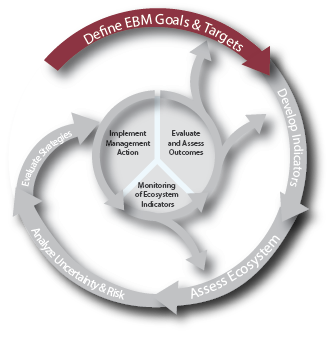The first step of the NOAA Integrated Ecosystem Assessment (IEA) approach is to clearly define goals and the system of interest. The term “scoping” is often used to describe this first step which includes defining:
- The system of interest, including relevant ecological, social, economic characteristics, and their relationships with partners and stakeholders
- Management or planning goals and objectives
Both pieces of this step provide the scope and scale of the work to be done and guide implementation of the rest of the iterative IEA approach.
Benefits of Defining the System and Management Goals
This is an important first step in effectively supporting marine resource use and management. Defining goals provides focus and a measure for progress. In order to achieve those goals it is key to understand the place and context, or ecosystem (including inter-related system components), within which use and management take place.
For scoping to be effective, ongoing communication and engagement with and between scientists, managers, stakeholders, and other users of the marine ecosystem is critical from the outset. Success requires that dialog and trusted relationships between all partners be established and communication and feedback be “early and often” - cultivated and maintained throughout collaborative implementation of the IEA approach.
A Tool to Define the Ecosystem: Conceptual Models
Conceptual models are a tool used as part of the NOAA Integrated Ecosystem Assessment to define the ecosystem of interest and help they help convey our understanding of ecosystem structure and function. Conceptual models are developed through a highly collaborative and iterative process that is participatory, consensus-based, and discussion-driven and includes user groups, other stakeholders, managers, and social and ecological scientists. During this process, participants define the components that make up that ecosystem — ecosystem components — and importantly the relationships, connections, and feedbacks between those components. This can also be described as defining the socio-ecological system (SES) of interest where the biophysical and human systems are coupled. As the name would imply, the coupled SES is made up of linked social, cultural, economic and ecological components.
Conceptual models help identify, and visualize, the multitude of ecosystem components that make up the SES, but also importantly help define the interconnections between those components, linking the environmental drivers, human activities, ecological interactions, and societal benefits.
In addition, conceptual models facilitate additional multi- and inter-disciplinary analyses, allowing further understanding of how changes in one component in the system might influence other components in the system. This ultimately provides an ecosystem context to support management decisions.
In summary conceptual models:
- Are a good communication and engagement tool
- Provide a unifying framework across people and disciplines (i.e. natural and social scientists; managers and policy frameworks; industries and local communities)
- Promote dialog among interested parties
- Increase and visualize understanding of complex system dynamics and relationships
- Link and integrate concepts across ecological and socio-economic components; enable consistent analyses across components
- Help identify and define what indicators are needed for each ecosystem component (e.g. what do we need to measure?)
- Help integrate scientists across ecological and socio-economic components by visually defining what they need to do together
- Help define what needs to be included in ecosystem models
- Show managers with different mandates how they all fit together
- Help anticipate trade-offs of potential management actions across components in a system
- Depict human activities (positive and negative) as a central aspect of the system (Humans as not just “antagonists” in the system, but fully integrated as part of the system)
- Facilitate integration of information and collaboration across disciplines to enable implementation of management in an informed, holistic, ecosystem context

